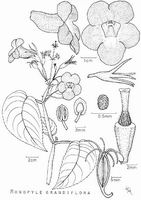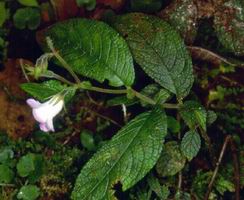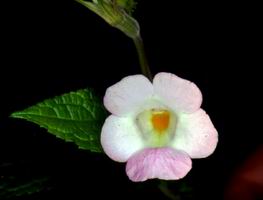
Selbyana 5, t. 4a (1978)
Full name and orig. publication: Monopyle Moritz ex Benth., in Benth. & Hook. f., Gen. pl. 2: 997 (May 1876).
Etymology: From the Greek μονος, monos = single, and πυλη, pylē = door, gate, opening. The name alludes to the capsular fruit which opens by a single (dorsal) slit.
Synonym: Scoliotheca Baill. (1888).
Infrafamilial position: Gesnerioid Gesneriaceae (Gesnerioideae) - Gloxinieae.
Description: Terrestrial, perennial herbs, with scaly rhizomes. Stem erect or decumbent, terete, slender, usually branched. Leaves opposite, anisophyllous, sometimes appearing alternate, joined across the stem in a stipular line; petiolate; lamina membranous, the base usually strongly oblique, often bullate or areolate above. Indumentum of hooked (uncinate) hairs. Flowers in a terminal thyrse or raceme, emerging from small bracts. Corolla somewhat zygomorphic; tube open-campanulate, base rounded, narrowed, or slightly saccate; limb 5-lobed, flaring, white or white with blue, sometimes yellow in the throat. Stamens 4; filaments slender, curved inwardly, adnate to corolla base; anthers coherent, thecae divergent, connective thick. Nectary much reduced or lacking. Ovary inferior, narrowly turbinate; style thick; stigma stomatomorphic. Fruit a dry, linear-oblong capsule, topped by the persistent calyx, opening by a dorsal slit.
Chromosome number: 2n = 26.
Species number: 17.
Species names (incl. publication and synonyms): See Skog, L.E. & J.K. Boggan. 2005: World checklist of Gesneriaceae: http://persoon.si.edu/Gesneriaceae/Checklist.
Type species: Monopyle leucantha Moritz ex Benth. = M. subdimidiata (Klotzsch & Hanst.) Mansf.
Distribution: Along the western Cordillera from Bolivia to Guatemala.
Ecology: Terrestrial plants growing in wet, shady places in forests, lowland to montane forests.
Notes: Diagnostic features of the genus are the strongly anisophyllous leaves, the open-campanulate corolla and the ± obsolete nectary. The faint fragrance and the presence of an osmophore near the corolla base indicate andro-euglossophily. The characteristic fruit (a fleshy capsule splitting on its dorsal side) is shared with several taxa previously placed in Gloxinia. Different is the anisophylly of the leaves and the presence of uncinate (hooked) hairs.
Selected references: Wiehler, Selbyana 6: 167 (1983); Skog, Ann. Missouri Bot. Gard. 65: 942-946 (1979), reg. rev. (Panama); Roalson, Boggan, Skog, Zimmer, Taxon 54(2): 389-410 (2005a), molec. syst.; Roalson, Boggan, Skog, Selbyana 25(2): 225-238 (2005b), tax.
Bibliography: See Skog, L.E. & J.K. Boggan. 2005. Bibliography of the Gesneriaceae. 2nd edition: http://persoon.si.edu/Gesneriaceae/Bibliography.
Illustrations:
 |
Monopyle grandiflora Wiehler
Selbyana 5, t. 4a (1978) |
|

|

|
Monopyle macrocarpa Benth.
Costa Rica, Alajuela, Valle Virgen, phot. A. Weber (1998) |
last modified: 2007-01-05